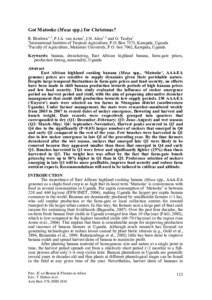| dc.contributor.author | Birabwa, R. |
| dc.contributor.author | Asten, Piet J.A. van |
| dc.contributor.author | Alou, I.N. |
| dc.contributor.author | Taulya, G. |
| dc.date.accessioned | 2019-12-04T11:14:02Z |
| dc.date.available | 2019-12-04T11:14:02Z |
| dc.date.issued | 2010 |
| dc.identifier.citation | Birabwa, R., Van Asten, P.J.A., Alou, I.N. & Taulya, G. (2010). Got matooke (Musa spp.) for Christmas? In IV International Symposium on Banana: International Conference on Banana and Plantain in Africa. Acta Horticulturae, 879, 113-121. |
| dc.identifier.issn | 0567-7572 |
| dc.identifier.uri | https://hdl.handle.net/20.500.12478/2620 |
| dc.description.abstract | East African highland cooking banana (Musa spp., ‘Matooke’, AAA-EA genome) prices are sensitive to supply dynamics given their perishable nature. Despite large temporal fluctuations in farm-gate prices and food security, no efforts have been made to shift banana production towards periods of high banana prices and low food security. This study evaluated the influence of sucker emergence period on harvest period and yield, with the aim of proposing alternative desucker management that could shift production towards low supply periods. 150 AAA-EA (‘Enyeru’) mats were selected on ten farms in Ntungamo district (southwestern Uganda). Under farmer management, the mats were researcher-monitored weekly from 2005 to 2007 to record dates of sucker emergence, flowering and harvest and bunch weight. Date records were respectively grouped into quarters that corresponded to dry (Q1: December–February; Q3: June–August) and wet seasons (Q2: March–May; Q4: September–November). Harvest peaks occurred in Q3 and Q4 due to the significantly (P<0.05) larger numbers of suckers that emerged in Q4 and early Q1 compared to the rest of the year. Few bunches were harvested in Q1 due to low sucker emergence in late Q1 of the preceding year. By the time farmers desuckered after the wet season, suckers that emerged late Q1 were likely to be removed because they appeared smaller than those that emerged in Q4 and early Q1. Bunches harvested in Q1 were fewer and significantly lighter (25%) than those harvested in Q3. The weight loss was offset by the fact that farm-gate bunch prices/kg were up to 50% higher in Q1 than in Q3. Preference selection of suckers emerging in late Q1 will be more profitable, improve food security and reduce farm nutrient exports. Recommendations will need to be tailored to cultivar and altitude. |
| dc.format.extent | 113-121 |
| dc.language.iso | en |
| dc.subject | Bananas |
| dc.subject | Desuckering |
| dc.subject | East African |
| dc.subject | Highland Banana |
| dc.subject | Farm-Gate Prices |
| dc.subject | Production Timing |
| dc.subject | Seasonality |
| dc.title | Got matooke (Musa spp.) for christmas? |
| dc.type | Journal Article |
| dc.description.version | Peer Review |
| cg.contributor.affiliation | International Institute of Tropical Agriculture |
| cg.contributor.affiliation | Makerere University |
| cg.coverage.region | Africa |
| cg.coverage.region | East Africa |
| cg.coverage.country | Uganda |
| cg.authorship.types | CGIAR and developing country institute |
| cg.iitasubject | Banana |
| cg.iitasubject | Plant Production |
| cg.iitasubject | Markets |
| cg.iitasubject | Farm Management |
| cg.journal | Acta Horticulturae |
| cg.howpublished | Formally Published |
| cg.accessibilitystatus | Limited Access |
| local.dspaceid | 93424 |
| cg.targetaudience | Scientists |

